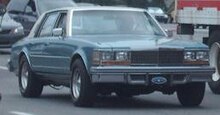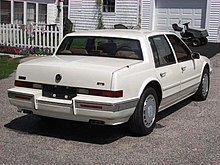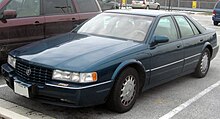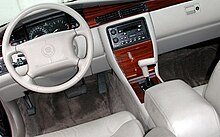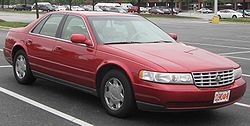Cadillac Seville
| Cadillac Seville | |
|---|---|
| Production period: | 1975-2003 |
| Class : | upper middle class |
| Body versions : | limousine |
| Successor: | Cadillac STS |
Cadillac Seville was the name of several car model series of the automobile manufacturer Cadillac , which were produced between spring 1975 and the end of 2003.
The Seville series were comparatively compact luxury vehicles that were smaller than the vehicles of the DeVille series, but at the same time were offered at significantly higher prices. They were technically related to other Group vehicles, but were intended to give the impression of independence through individually designed bodies.
Eldorado Seville (1956-1960)
In the 1950s the name Seville referred to the hardtop version of the Cadillac Eldorado .
Seville (1975-1980)
| First generation | |
|---|---|
|
Cadillac Seville (1977-1980) |
|
| Production period: | 1975-1980 |
| Body versions : | limousine |
| Engines: |
Otto engine : 5.7 liters Diesel engine : 5.7 liters |
| Length: | 5180 mm |
| Width: | 1825 mm |
| Height: | 1390 mm |
| Wheelbase : | 2905 mm |
| Empty weight : | 1970 kg |
background
The first series of the Cadillac Seville was introduced in May 1975. With it, General Motors responded to the increasing interest of American customers in compact luxury vehicles. The external reason for this was the oil crisis at the beginning of the 1970s. In the USA, it had led to a move towards smaller, more economical vehicles, which, in the absence of domestic alternatives, were primarily imported from Europe and Japan.
Initially, compact import models were only successful in the lower price segment; However, the importers increasingly managed to also occupy the high-priced area. It was primarily German manufacturers who achieved success with technically high-quality vehicles such as the Mercedes-Benz “Stroke Eight” and the BMW E3 . American manufacturers initially had nothing to counter this. General Motors was the first of the big three American automobile companies to recognize a potential market for domestic models. Starting in 1975, this gap was filled with the Cadillac Seville, which was 50 cm shorter and almost 450 kg lighter than the full-size models of the DeVille series and thus roughly corresponded in its dimensions to the US version of the contemporary S-Class from Mercedes-Benz . Despite its very high price, the Seville was able to establish itself well on the American market without, of course, overtaking the German imported vehicles.
Two years later, Ford and Chrysler followed suit with the Lincoln Versailles and the LeBaron, respectively . However, they were nowhere near as successful as the Cadillac Seville. This was mainly due to the fact that both the Lincoln and the Chrysler were only slightly modified mid-range models, whose relationship to the basic models was easily recognizable. The Cadillac Seville, on the other hand, was at least outwardly a completely independent model that did not seem to have any recognizable connections to cheaper group vehicles.
The name Seville goes back to the Spanish city of Seville . Cadillac had used this term from 1956 to 1960 as an additional designation for particularly high-quality hardtop coupés that had been marketed as Eldorado Seville . General Motors originally considered naming Cadillac's small vehicle "Leland" (after Henry Martin Leland, the brand's founder). This was soon abandoned, however, as it was feared that many of the younger buyers would not be able to assign the name or would instead create an undesirable association with the British car manufacturer British Leyland .
It was also considered to revive the name LaSalle , under which the cheaper Cadillac models had been marketed in the 1930s and 1940s. This idea was not implemented either; allegedly the name LaSalle had the "image of a loser"
Model history
When developing the Cadillac Seville, the engineers were required to use existing in-house components. Initially, it was considered to derive the "Baby Cadillac" from the Opel Diplomat , which in its highest quality equipment level was powered by an American eight-cylinder engine. However, this vehicle was not imported into the United States, so the use of German components would have required the complex rebuilding of the parts supply in the USA. This solution could therefore not be implemented for cost reasons. Instead, the was X platform of General Motors used as a basis, in vehicles such as the since 1968 Chevrolet Nova was used. This basis has been extensively revised; especially the chassis and the brakes were adjusted so that the little Cadillac should compete with German vehicles.
During test drives, observers came to the conclusion that the Seville had the “best driving behavior of a Cadillac in living memory”: Although the Seville did not come close to the driving behavior of a Mercedes-Benz 450 SEL 6.9 , it was also significantly cheaper.
Initially a 5.7 liter (350 cubic inch) eight-cylinder engine supplied by Oldsmobile served as the drive . The engine was equipped with electronic fuel injection as standard and developed 180 hp.
With the beginning of the 1978 model year, a diesel engine of the same size was available as an alternative, which was also manufactured by Oldsmobile and delivered 120 hp. The engine suffered from significant reliability problems and was rarely ordered. The power transmission was carried out as standard by a three-speed automatic.
Unlike in the case of the later competitors from Lincoln and Chrysler, the Seville received a completely separate body. In contrast to the sweeping shapes of the DeVille series, the lines were straight and straightforward. Only the typical radiator grille with chrome-plated grilles ("Eggcrate grille" or egg box grill) made a reference to the Cadillac brand. For the first two years, the Seville was only available with a vinyl-covered roof. The cover was supposed to hide a weld seam in the metal structure, which was created by joining the roof from two separately manufactured components: The front roof part corresponded to the inexpensive models of the X-Bodies, while the rear roof part was produced exclusively for the Seville. Since many customers wanted to distance themselves from the vinyl roof, Cadillac was forced to manufacture a new roof for the Seville, pressed in a cohesive piece, from 1977, which allowed painting in the body color.
The Cadillac Seville was one of the most expensive automobiles made in America. When it was first launched, the basic version was priced at $ 12,500. It was the most expensive Cadillac - apart from the long wheelbase Cadillac Seventy-Five sedan. He kept this position until the end of his production.
Over the years, in addition to the basic version, some special models were created that were sold at much higher prices:
- This includes the Cadillac Seville Elegante , which was offered from 1978. It was characterized by almost complete standard equipment and was externally recognizable by a two-tone paintwork.
- In 1979 Cadillac also offered a Seville Gucci , which had a high-quality leather interior and was externally recognizable by a vinyl cover that extended over the C-pillar. The renovation work was carried out on a factory contract by a Miami-based company. The Seville Gucci was priced at $ 23,000. It was $ 9,000 more expensive than the base Cadillac Seville.
distribution
The first series of the Cadillac Seville was a successful automobile. Production did not even come close to the level of the full-size DeVille and Fleetwood Brougham models in any year. However, the Seville was almost 50 percent more expensive than the standard models. In five years, Cadillac produced over 215,000 copies of the Seville.
In the first year of production 16,355 vehicles were produced, in 1976 43,772 vehicles were built. In 1977 Cadillac could manufacture 45,060 Sevilles. The most successful model year was 1978 when almost 57,000 vehicles were produced. In the last year of production, another 53,487 vehicles were produced.
In Iran , the model was assembled from 1977 to 1980 by Iran General Motors under the model name Cadillac Civil .
Seville (1980-1985)
| Second generation | |
|---|---|
|
Cadillac Seville (1984) |
|
| Production period: | 1980-1985 |
| Body versions : | limousine |
| Engines: |
Otto engines : 4.1–6.0 liters (93–104 kW) Diesel engine : 5.7 liters (78 kW) |
| Length: | 5202 mm |
| Width: | 1801-1814 mm |
| Height: | 1379 mm |
| Wheelbase : | 2896 mm |
| Empty weight : | 1970 kg |
The second-generation Seville had a much more eye-catching design than its predecessor, with the rear section in particular polarizing. This Seville had front-wheel drive and largely corresponded to the Cadillac Eldorado of that time . The introduction began in the fall of 1980.
The shape of the second Seville was created by Wayne Kady and was intended to be a monument to the outgoing General Motors chief designer William Mitchell . The rear roofline dropped sharply. At the same time, the trunk was set up in the manner of a British luxury sedan. Cady cited the so-called Razor Edge Design , which was widespread in British luxury vehicles in the late 1930s, as well as the Empress Line from the British bodybuilder Hooper . The design was controversial, but temporarily shaped the style of the US upper class - both the Lincoln Continental of 1982 and the Chrysler Imperial , introduced in 1981, had similarly designed rear sections. The unusual lines of the Seville were supported by a two-tone paintwork.
The Seville was offered with a 5.7-l V8 diesel engine (78 kW, 1980–1985), the company's own 6.0-l V8 petrol engine (104 kW, only 1980), the so-called "V8-6- 4 "version of the six-liter engine (108 kW, 1981 only), Cadillac's new 4.1-liter V8 engine (93-101 kW, 1982-1985) and a 4.1-liter V6 engine from Buick (93 kW, 1981/82).
Technical innovations such as the electric trunk closing assist or electronic speedometer underlined Cadillacs status as an innovation leader, the vulnerable "V8-6-4" engine in which the cylinder deactivation should reduce fuel consumption, however, failed because of technical problems and, after just one year removed from the program again.
198,000 pieces of the second generation Seville left the production line.
Seville (1985-1991)
| Third generation | |
|---|---|
|
Cadillac Seville STS (1990) |
|
| Production period: | 1985-1991 |
| Body versions : | limousine |
| Engines: | Otto engine : 4.9 liters (149 kW) |
| Length: | 4846 mm |
| Width: | 1801-1829 mm |
| Height: | 1329-1364 mm |
| Wheelbase : | 2743 mm |
| Empty weight : | |
By the fall of 1985 the Seville had changed fundamentally. The conservative shape with a massive rear and steep rear window should be mentioned here. In addition, the entire body had become even more compact. This was made possible by the fact that the Seville was the first production car in the world with a transversely installed V8 engine. The displacement and output of this third Seville generation grew steadily; The 4.1-l V8 engine from 1986/1987 (97 kW) was followed in 1988/1989 by a 4.5-l V8 engine with 115 kW, which was increased to 135 kW in 1990, and finally a 4 in 1991 , 9 l V8 engine with 149 kW.
From 1988 the Seville was available with the Sport-Touring-Sedan package (STS for short), which ensured better road holding with a stiffer sport chassis and achieved the status of an independent model variant in the successor.
For the American clientele, the Seville, which had shrunk to a good 4.80 m, was probably a size too small; sales continued to shrink to a total of 142,000 copies.
Seville (1991-1997)
| Fourth generation | |
|---|---|
|
Cadillac Seville (1991-1994) |
|
| Production period: | 1991-1997 |
| Body versions : | limousine |
| Engines: |
Petrol engines : 4.6-4.9 liters (149-224 kW) |
| Length: | 5192 mm |
| Width: | 1885 mm |
| Height: | 1384 mm |
| Wheelbase : | 2819 mm |
| Empty weight : | 1673 kg |
The fourth generation Seville grew considerably, to 5192 mm, and presented itself with a very modern, European-looking body design. With this model Cadillac wanted to modernize the image of the brand. The design of the car is based on the Cadillac Voyage study presented in 1988 .
The range included the Seville Luxury Sedan (SLS for short), which in 1992/93 still featured the well-known 4.9-l V8 engine with 149 kW (203 hp), and from 1994 to 1997 a 204 kW (278 hp) engine Variant of the Northstar V8 engine was powered, and the Seville Touring Sedan (STS) with the 149 kW engine (only model year 1992) or the 4.6 l Northstar engine, which is here on 224 kW (304 PS) came. A special feature of this Seville generation was the front-wheel drive with an automatic lock . The seating position could therefore be kept unusually low for a limousine.
In the Cadillac model hierarchy, the Seville with a length of 5.19 meters was considered a compact car, which is why it was described as almost European in an endurance test carried out by Auto Motor und Sport in 1996 . Equipment features such as automatically switching on headlights, automatically releasing foot parking brake, self-closing trunk, automatically dimming interior mirrors were already among the basic equipment of a Cadillac Seville back then.
In Europe, the Seville was compared to conventional luxury sedans because of its dimensions and only offered in the most powerful and best-equipped version, the STS, because of the possible high motorway speeds. This had a reinforced gearbox and oil cooler for the engine, gearbox and power steering. The less powerful version SLS had fewer features and a speed limit at 200 km / h. The sales figures for the Seville were below those of the German competition ( Mercedes-Benz S-Class , BMW 7 Series ). In North America, on the other hand, positioned above the Cadillac DeVille in terms of price , it was able to show considerable sales success.
Cadillac produced a total of 247,000 copies of the fourth generation Seville.
Seville (1997-2004)
| Fifth generation | |
|---|---|
|
Cadillac Seville (1997-2004) |
|
| Production period: | 1997-2004 |
| Body versions : | limousine |
| Engines: |
Petrol engines : 4.6 liters (205–224 kW) |
| Length: | 5105 mm |
| Width: | 1905 mm |
| Height: | 1415 mm |
| Wheelbase : | 2850 mm |
| Empty weight : | 1800-1815 kg |
In the late summer of 1997, Cadillac presented, formally at the IAA , a new Seville that was technically related to the Oldsmobile Aurora . Outwardly, the new model was very similar to its predecessor, but had changes to the technology and chassis. Once again, an SLS and an STS were on offer with a maximum output of 205 kW and 224 kW respectively. The vehicle is based on General Motors' G platform . From the beginning, both Seville models received the Magneticride active chassis .
Production of the STS ceased in May 2003, while that of the SLS ended in December 2003. The production site was GM's Detroit-Hamtramck plant. Its successor was the Cadillac STS with rear-wheel drive , which was manufactured from spring 2005 to mid-2011 .
Individual evidence
- ↑ Bochroch: American Cars of the Seventies, p. 35
- ↑ In the original: "loser image". The not particularly successful LaSalle brand was discontinued before the Second World War. See Langworth: Encyclopedia of American Cars 1930–1980, p. 94.
- ^ Langworth: Encyclopedia of American Cars 1930-1980, p. 94.
- ↑ On the history of development cf. Langworth: Encyclopedia of American Cars 1930-1980, p. 94.
- ^ Langworth: Encyclopedia of American Cars 1930-1980 , p. 94.
- ↑ Bochroch: American Cars of the Seventies, p. 35
- ↑ a b Eckhard Eybl: Good buy? In: auto motor und sport . October 2, 1996, accessed July 19, 2009 .
- ↑ 1988 Cadillac Voyage Concept . Retrieved January 19, 2015.
- ^ Thomas E. Bonsall: The Cadillac Story: The Postwar Years . Stanford University Press, 2004, ISBN 978-0-8047-4942-8 , pp. 187 (English, google.com ).
- ^ Rik Paul: '98 Cadillac Seville - First Drive - Motor Trend. In: motortrend.com. October 7, 1997. Retrieved July 31, 2018 (American English).
- ↑ Detroit-Hamtramck - About. In: plants.gm.com. Retrieved July 31, 2018 .
swell
- Flammang, James M./Kowalke, Ron: Standard Catalog of American Cars 1976-1999. Krause Publications, Iola 1999. ISBN 0-87341-755-0
Web links
| Cadillac models timeline , 1930s to 1980s | ||||||||||||||||||||||||||||||||||||||||||||||||||||||||||||
|---|---|---|---|---|---|---|---|---|---|---|---|---|---|---|---|---|---|---|---|---|---|---|---|---|---|---|---|---|---|---|---|---|---|---|---|---|---|---|---|---|---|---|---|---|---|---|---|---|---|---|---|---|---|---|---|---|---|---|---|---|
| Type | 1930s | 1940s | 1950s | 1960s | 1970s | 1980s | ||||||||||||||||||||||||||||||||||||||||||||||||||||||
| 0 | 1 | 2 | 3 | 4th | 5 | 6th | 7th | 8th | 9 | 0 | 1 | 2 | 3 | 4th | 5 | 6th | 7th | 8th | 9 | 0 | 1 | 2 | 3 | 4th | 5 | 6th | 7th | 8th | 9 | 0 | 1 | 2 | 3 | 4th | 5 | 6th | 7th | 8th | 9 | 0 | 1 | 2 | 3 | 4th | 5 | 6th | 7th | 8th | 9 | 0 | 1 | 2 | 3 | 4th | 5 | 6th | 7th | 8th | 9 | |
| Middle class | 60 | 61 | 2nd ww | 61 | Cimarron | |||||||||||||||||||||||||||||||||||||||||||||||||||||||
| 355 | 70/80 | 62 | Series 62 | 6200 | Calais | |||||||||||||||||||||||||||||||||||||||||||||||||||||||
| upper middle class | Seville | |||||||||||||||||||||||||||||||||||||||||||||||||||||||||||
| Upper class | 65 | Coupe DeVille / Sedan DeVille | ||||||||||||||||||||||||||||||||||||||||||||||||||||||||||
| 60S | Sixty Special Fleetwood | Flwd60S | Fleetwood | |||||||||||||||||||||||||||||||||||||||||||||||||||||||||
| Limousines | 355 | 72/75/85 | Series 75 | 6700 | Fleetwood 75 | FL | FB | Brougham | ||||||||||||||||||||||||||||||||||||||||||||||||||||
| Personal Luxury | Eldorado | |||||||||||||||||||||||||||||||||||||||||||||||||||||||||||
| Roadster | Allante | |||||||||||||||||||||||||||||||||||||||||||||||||||||||||||
| Luxury class | V-16 | Brougham | ||||||||||||||||||||||||||||||||||||||||||||||||||||||||||

